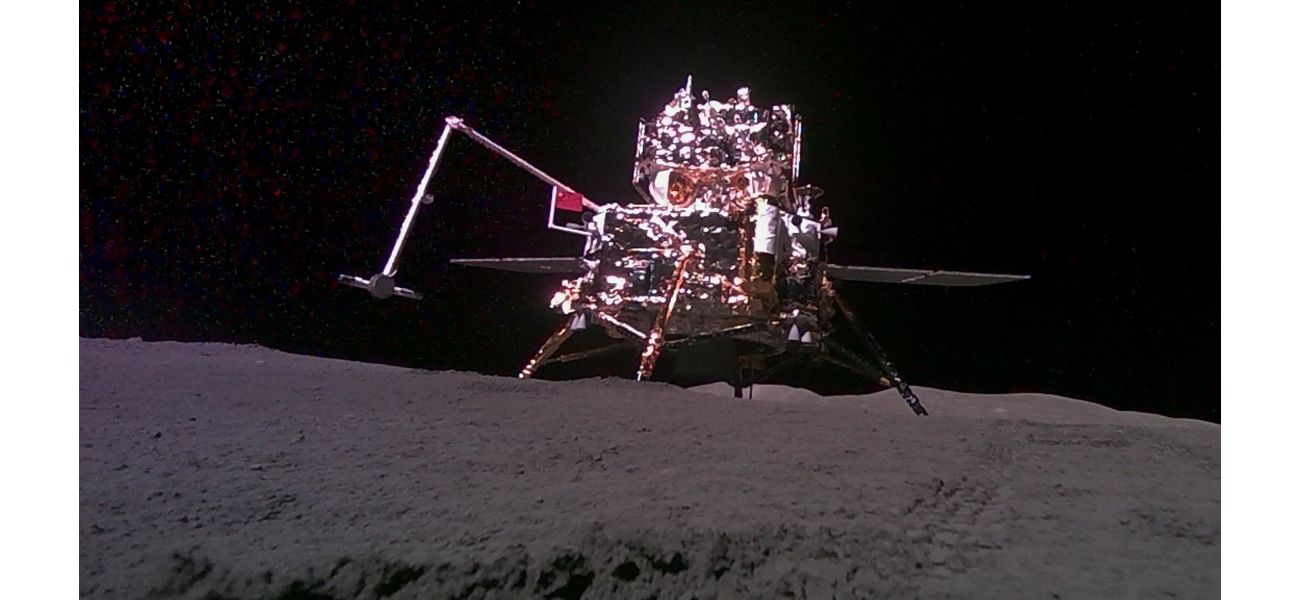Ancient rock confirms volcanic activity on dark side of moon over 4 billion years ago.
It's crucial to gather a sample from this area since we lack any data for it.
November 16th 2024.

After a successful landing on the moon's surface, the Chang'e-6 probe, equipped with a mini rover, embarked on a groundbreaking mission. It collected samples from the mysterious far side of the moon, where volcanoes are said to have erupted billions of years ago. This exciting discovery was confirmed through the analysis of lunar soil brought back to Earth by the spacecraft.
The Chang'e-6 spacecraft, launched by China, was the first to return from the little-explored far side with a haul of rocks and dirt. Upon examination, two different teams of scientists discovered fragments of volcanic rock that were estimated to be around 2.8 billion years old. One of these pieces was even more ancient, dating back to a staggering 4.2 billion years.
According to Christopher Hamilton, a planetary volcano expert from the University of Arizona, this achievement holds great significance. He stated, "To obtain a sample from this area is really important because it's an area that otherwise we have no data for." It is a region that has remained largely unexplored, and this groundbreaking mission has shed light on its mysterious past.
The near side of the moon, the part that is visible from Earth, has been known to have active volcanoes dating back to a similar time frame. Previous studies, including data from NASA's Lunar Reconnaissance Orbiter, had hinted at the possibility of a volcanic past on the far side as well. Now, with the first samples from this region, this theory has been confirmed.
Images taken by the panoramic camera on the Chang'e-6 lander reveal a rugged and cratered lunar surface. This is in stark contrast to the near side, which is characterized by flat, dark plains carved by lava flows. The drastic differences between the two halves of the moon remain a mystery, as highlighted by Qiu-Li Li, co-author of the study from the Chinese Academy of Sciences.
Li further explained that the new findings suggest a history of over one billion years of volcanic eruptions on the far side of the moon. This discovery opens up avenues for further research to delve into the reasons behind the prolonged activity on this side of the moon. With this groundbreaking mission, China has yet again made a significant contribution to our understanding of the moon.
In 2020, the Chang'e-5 spacecraft returned with moon rocks from the near side, marking the first such collection since the 1970s when NASA's Apollo astronauts and the Soviet Union's spacecraft brought back samples. Prior to that, in 2019, the Chang'e-4 spacecraft made history by being the first to land on the far side of the moon.
The Beijing Aerospace Control Center was abuzz with excitement as they witnessed the Chang'e-6 probe collecting samples on the moon through a screen replay. This mission has not only provided valuable insights into the moon's geological history but has also paved the way for future research to uncover even more secrets of this enigmatic celestial body.
The Chang'e-6 spacecraft, launched by China, was the first to return from the little-explored far side with a haul of rocks and dirt. Upon examination, two different teams of scientists discovered fragments of volcanic rock that were estimated to be around 2.8 billion years old. One of these pieces was even more ancient, dating back to a staggering 4.2 billion years.
According to Christopher Hamilton, a planetary volcano expert from the University of Arizona, this achievement holds great significance. He stated, "To obtain a sample from this area is really important because it's an area that otherwise we have no data for." It is a region that has remained largely unexplored, and this groundbreaking mission has shed light on its mysterious past.
The near side of the moon, the part that is visible from Earth, has been known to have active volcanoes dating back to a similar time frame. Previous studies, including data from NASA's Lunar Reconnaissance Orbiter, had hinted at the possibility of a volcanic past on the far side as well. Now, with the first samples from this region, this theory has been confirmed.
Images taken by the panoramic camera on the Chang'e-6 lander reveal a rugged and cratered lunar surface. This is in stark contrast to the near side, which is characterized by flat, dark plains carved by lava flows. The drastic differences between the two halves of the moon remain a mystery, as highlighted by Qiu-Li Li, co-author of the study from the Chinese Academy of Sciences.
Li further explained that the new findings suggest a history of over one billion years of volcanic eruptions on the far side of the moon. This discovery opens up avenues for further research to delve into the reasons behind the prolonged activity on this side of the moon. With this groundbreaking mission, China has yet again made a significant contribution to our understanding of the moon.
In 2020, the Chang'e-5 spacecraft returned with moon rocks from the near side, marking the first such collection since the 1970s when NASA's Apollo astronauts and the Soviet Union's spacecraft brought back samples. Prior to that, in 2019, the Chang'e-4 spacecraft made history by being the first to land on the far side of the moon.
The Beijing Aerospace Control Center was abuzz with excitement as they witnessed the Chang'e-6 probe collecting samples on the moon through a screen replay. This mission has not only provided valuable insights into the moon's geological history but has also paved the way for future research to uncover even more secrets of this enigmatic celestial body.
[This article has been trending online recently and has been generated with AI. Your feed is customized.]
[Generative AI is experimental.]
0
0
Submit Comment





